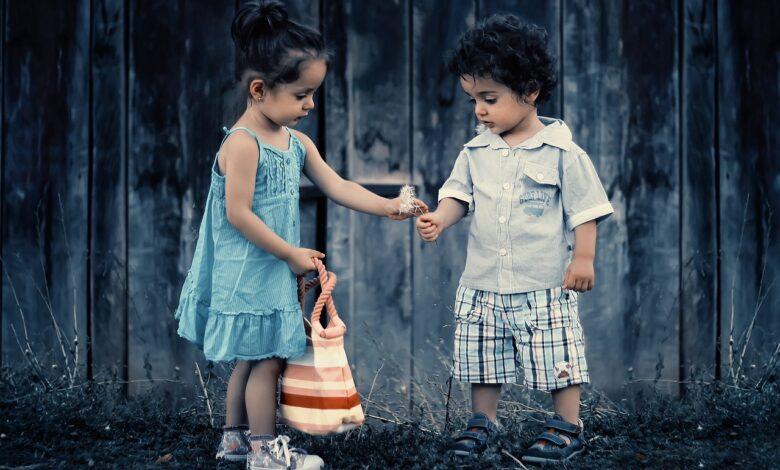Children Dream Meaning and Interpretation

Dreams have always been a source of mystique and curiosity, intertwining with reality in the most peculiar ways. Children, with their boundless imagination, often have dreams that are vibrant and whimsical. But what do these dreams signify? What hidden messages lie within the night-time escapades of the young mind? Delving into the realm of children’s dreams opens up a fascinating world rich in symbolism and meanings.
Interpretations of Children Dreams
Interpreting the dreamscapes of children can be both a bewildering and enlightening experience. Unlike adults, children’s dreams are often a blend of their real-time experiences and their imaginative adventures. The task of interpreting these dreams extends beyond mere analysis and taps into understanding the untouched realms of innocence and creativity. Here are several factors and considerations that come into play while interpreting children’s dreams:
- Literal Interpretations:
- Children, especially at a younger age, have a more direct representation of their daily experiences in their dreams. For example, a child who had a joyful day at the park may dream about colorful slides and playful swings.
- The characters in their dreams are often people they interact with daily like parents, siblings, or classmates. It’s relatively common to find direct correlations between their waking life and dream content.
- Fear and Anxiety Representation:
- Nightmares or unsettling dreams often stem from fears and anxieties a child may be experiencing. For instance, a child feeling anxious about the first day of school might dream about getting lost in a vast, unfamiliar building.
- Addressing and talking through these fears in a comforting manner can sometimes lead to a resolution in the dream narrative over time.
- Desire Fulfillment:
- Emotional Processing:
- Dreams act as a vent for children to process their emotions. If a child is going through a phase of emotional turmoil, such as parents separating or a move to a new city, their dreams might reflect elements of sadness, confusion or even anger.
- Through the narrative of their dreams, children often work through the emotional upheaval, finding a sense of closure or acceptance.
- Creative Expression:
- The unbounded imagination of children often soars freely in the dream realm. Elements of fantasy, whimsy, and creativity manifest vividly, often showcasing their imaginative spirit.
- Dreams of flying, exploring unknown lands, or befriending fantastical creatures often mirror a child’s inherent creative expression and the boundless curiosity to explore the unknown.
Unraveling the intricate narratives within a child’s dream requires a delicate approach that respects their emotions and imaginative expressions. By engaging in open conversations with children about their dreams, adults can foster a supportive environment where children feel safe to share and explore the unique and often insightful world of their dreams.
What is the Symbolism of Children?
The symbolism attached to children, both in dreams and in broader cultural or psychological contexts, is vast and nuanced. Whether appearing in the dreams of adults or their own dreams, children often carry significant symbolic messages. Below are some of the symbolic interpretations associated with children:
- Innocence and Purity:
- Children are frequently seen as embodiments of innocence and purity. Their untarnished view of the world represents a state of grace and untouched potential.
- In dreams, the appearance of children may remind the dreamer of their own innocence or a desire to return to a less complicated state of being.
- Growth and Development:
- The process of growing, learning, and evolving is vividly encapsulated in the symbolism of children. They represent the phase of life where everything is a learning experience, and every day brings new growth.
- A child in a dream might symbolize personal development, hinting at the dreamer’s ongoing growth or potential for self-discovery and evolution.
- Hope and Future:
- Children often symbolize hope for the future and the continuation of legacy. They embody the promise of new beginnings and potential fulfilled.
- Dreaming of children might symbolize an optimistic outlook towards the future or the nurturing of new ideas and ventures.
- Vulnerability and Dependency:
- With their need for care and guidance, children symbolize vulnerability and dependency. They remind us of the aspects of ourselves that require nurturing and protection.
- In dreams, children might represent personal vulnerabilities or areas of dependency that need acknowledgment and care.
- Creativity and Imagination:
- The boundless imagination of children symbolizes the untamed creative spirit. Their ability to see the world through a lens of curiosity and wonder is a reminder of the power of imagination.
- Encountering children in dreams could symbolize a rekindling of creative energies or an invitation to explore one’s imaginative potential.
- Inner Child:
- On a psychological level, children in dreams often represent the dreamer’s inner child. This aspect of the symbolism taps into the dreamer’s emotions, memories, and experiences from their own childhood.
- Encountering one’s inner child in a dream might prompt a revisiting of past experiences, a healing of old wounds, or a reconnection with forgotten aspects of oneself.
The symbolism of children is a rich tapestry of meanings, encompassing various aspects of human experience. Engaging with this symbolism, either through dream interpretation or introspective exploration, can offer profound insights into one’s life, aspirations, and personal journey.
Common and Typical Dreams of Children
Children’s dream worlds are as varied and unique as their waking experiences, often reflecting their emotions, desires, and encounters with the world around them. Here are some common and typical dream themes among children and possible interpretations:
- Flying Dreams:
- Flying is a common dream theme among children, symbolizing a sense of freedom, escapism, or empowerment. It might reflect a child’s desire for independence or a break from real-world restrictions.
- Example: A child feeling constrained by school rules might dream of flying, embodying a wish for freedom.
- Being Chased:
- Dreams of being chased or threatened often mirror anxieties or fears a child might be facing in reality. It could represent a situation or person the child finds intimidating.
- Example: A child anxious about being bullied might have recurring dreams of being chased by a menacing figure.
- Falling Dreams:
- Falling can signify feelings of insecurity, loss of control, or fear of failure. It might reflect a child’s struggles with new challenges or fear of disappointing others.
- Example: A child who has recently moved to a new school might dream of falling, symbolizing a fear of the unknown or a sense of loss.
- Adventure Dreams:
- Children often have dreams filled with adventure, exploring unknown lands, or encountering fantastical creatures. These dreams reflect their inherent curiosity and explorative nature.
- Example: A child curious about nature might dream of jungle adventures with talking animals, symbolizing their zest for exploration.
- Losing or Finding Objects:
- Dreams of losing or finding objects could reflect a child’s concerns about possession, attachment, or discovery.
- Example: A child might dream of losing their favorite toy, symbolizing fears of loss or change.
- School or Classroom Settings:
- Dreams set in schools or classrooms may mirror a child’s experiences, anxieties, or aspirations related to learning and social interactions.
- Example: A dream about acing a test might reflect a child’s desire for approval and success.
- Animal Companions:
- Animals in children’s dreams often embody qualities the child admires or desires, symbolizing companionship, protection, or personal traits.
- Example: A child might dream of befriending a lion, symbolizing a desire for courage or protection.
These common dream themes can offer a glimpse into a child’s inner world, reflecting their ongoing processes of learning, adapting, and imagining. While individual interpretations might vary, understanding the overarching themes can provide valuable insights for parents, caregivers, and educators, enabling them to support the child’s emotional and psychological well-being effectively.
Children in Dream: Themes & Visions
Children-related dreams experienced by adults are a complex domain that encapsulates a variety of emotions, desires, fears, and aspects of self-reflection. These dreams can reflect one’s inner child, aspirations, fears, or the nurturing aspect of one’s personality. Here’s a deeper look into various facets of children-related dreams and their potential interpretations:
- Nurturing Aspects:
- Dreams of caring for a child might symbolize a nurturing aspect of the dreamer’s personality, indicating a desire to protect, guide, or support others in their life.
- Example: A dream about cradling a baby might reflect a nurturing attitude or a desire to care for others.
- Unfulfilled Desires or Regrets:
- Sometimes, dreams involving children might bring to surface unfulfilled desires or past regrets. They can act as a window into missed opportunities or desires to redo certain aspects of life.
- Example: A dream about playing with children could symbolize a yearning for simpler times or unfulfilled desires from one’s childhood.
- Inner Child Encounters:
- Encountering one’s inner child in a dream can be a potent experience. It might reveal insights into unresolved childhood issues or the need to reconnect with lost innocence and joy.
- Example: Dreaming of conversing with a younger version of oneself might indicate a journey of self-reflection and healing.
- Fear of Parenthood or Responsibility:
- Dreams about children might also reflect fears or anxieties related to parenthood, responsibility, or the expectations associated with caring for others.
- Example: A dream about losing a child in a crowded place might symbolize fears of inadequacy or the overwhelming nature of responsibility.
- Potential and Future Aspirations:
- Children in dreams might symbolize potential, new beginnings, or future aspirations. They can represent hope, new projects, or a fresh outlook on life.
- Example: Dreaming about guiding a child might symbolize the nurturing of new ideas or ventures.
- Revisiting Past Relationships:
- Sometimes, these dreams can also facilitate a revisiting of past relationships or situations, providing a platform for processing old emotions or understanding previous experiences.
- Example: Dreaming about childhood friends or siblings might prompt a reflection on past relationships and their impact on the dreamer’s life.
- Healing and Acceptance:
- Children-related dreams might also symbolize a process of healing, acceptance, or the resolution of past conflicts.
- Example: A dream about reconciling with childhood figures might indicate a process of healing and acceptance.
Delving into children-related dreams can be an introspective journey, enabling the exploration of various facets of one’s psyche. By reflecting on these dreams and engaging with their symbolism, individuals might find pathways to personal growth, healing, and deeper understanding of their life experiences and relationships.
Psychological Perspectives
Children have always been subjects of fascination in the psychological realm due to their unique cognitive, emotional, and behavioral dynamics. Their dreams, too, are considered windows into their developing minds, showcasing the interplay of innate instincts, learned behaviors, and absorbed cultural norms. Here are several psychological perspectives on children, focusing on their dreaming patterns and associated meanings:
- Freudian Interpretation:
- Sigmund Freud’s theories often revolved around the idea of repressed desires and unconscious thoughts manifesting through dreams. In the case of children, their dreams might reflect nascent desires or attempts to make sense of the adult world around them.
- Example: A dream about seeking a hidden treasure might symbolize a child’s innate curiosity and exploratory instincts.
- Jungian Analysis:
- Carl Jung’s approach delves into the collective unconscious and archetypal symbols. Children’s dreams, from this perspective, might be seen as interactions with universal symbols which foster individual psychological growth.
- Example: A dream about a heroic quest might mirror a child’s self-realization journey and personal growth.
- Behaviorist Perspective:
- Behaviorists might interpret children’s dreams as reflections of learned behaviors and reactions to environmental stimuli. These dreams can be seen as rehearsals or responses to daily experiences.
- Example: A dream about navigating through a maze might reflect a child’s problem-solving skills developed through learning and experience.
- Cognitive Development Perspective:
- As children grow, their cognitive abilities evolve, impacting their dream content. Dreams can be seen as mirrors of a child’s cognitive and emotional development, showcasing their understanding of the world.
- Example: The complexity and narrative coherence of dreams often increase with a child’s age, reflecting their evolving cognitive abilities.
- Emotional Processing:
- Psychologists often see dreams as venues for emotional processing, helping children deal with fears, anxieties, and other emotions in a safe, imaginative space.
- Example: Dreams following a stressful event might help children process their emotions and come to terms with their experiences.
Exploring children’s dreams from these psychological perspectives can provide profound insights into their mental and emotional landscapes, offering valuable clues for supportive and nurturing guidance.
Children in Dreams: Insights from Culture & Mythology
Children often hold a significant place in various cultural narratives and mythological stories, symbolizing a myriad of concepts ranging from innocence and purity to hope and future potential. Here’s a look into how children are represented in culture and mythology:
- Symbol of Hope and Continuity:
- In many cultures, children are seen as symbols of hope, continuation of lineage, and bearers of future promise. Their birth is often celebrated as a new beginning and a continuation of tradition.
- Example: The birth of a child in royal families is often seen as a promise of continued legacy.
- Embodiment of Innocence:
- The innocence and purity associated with children are often depicted in cultural tales and mythological stories, portraying them as beings of untarnished goodness.
- Example: In various mythologies, children often play roles as pure-hearted heroes or divine entities.
- Harbingers of Divine Messages:
- Children, due to their perceived purity and closeness to the divine, are often depicted as messengers or favored by divine entities in many mythological narratives.
- Example: Child seers and prophets are common figures in many mythological and religious narratives.
- Representatives of Learning and Growth:
- The journey of growth, learning, and coming-of-age is a recurrent theme in cultural and mythological narratives. Children, in their quest for knowledge and self-discovery, embody this universal journey.
- Example: Mythological stories often feature young protagonists embarking on quests, symbolizing personal growth and self-discovery.
- Metaphors for Inner Potential:
- Children in mythology are often used as metaphors for untapped potential, new possibilities, and the inherent goodness of human nature.
- Example: Tales of child prodigies or divine children often symbolize the boundless potential inherent in human nature.
Exploring the representation of children in culture and mythology reveals the diverse roles and symbolic meanings attributed to them. Their portrayal provides a rich tapestry of insights into human nature, societal values, and the universal journey of growth and self-discovery.
Conclusion
Children Dream Meaning unveils a rich tapestry of symbolism and insights, both for the dreamer and the observer. Whether it is the whimsical dreams of a child or an adult’s dream featuring children, each narrative holds a wealth of meanings waiting to be explored. So the next time you or your child wake up from a dream, take a moment to reflect on the intricate messages it might be conveying, opening a doorway to a deeper understanding of the self and the world around.



